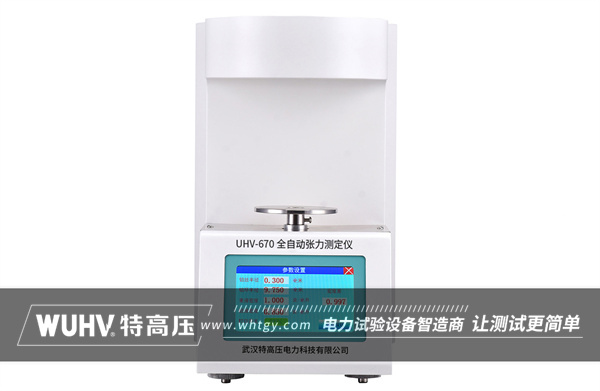The surface tension tester under the UHV power company can help many power workers conduct various power tests more conveniently.

Surface tension testing equipment is a specialized device used to measure the surface tension of liquids, which can help us understand the surface properties and quality of liquids. The following is a detailed explanation of the surface tension testing instrument:
1、 Definition
A surface tension testing instrument is a device that uses physical or chemical methods to measure the surface tension of liquids. It can accurately measure the magnitude of liquid surface tension, providing effective data support for liquid applications, production, quality control, and other aspects.
2、 Principle
The surface tension testing instrument mainly uses principles such as equilibrium method, maximum reduction angle method, and dynamic method for testing. Among them, the balance method is the most basic testing method, which suspends a weighing rod or ring on the surface of the tested liquid, measures the balance relationship between the force generated by the rod or ring on the liquid surface and the weight of the rod or ring, and thus determines the magnitude of the tension on the liquid surface. The maximum reduction angle rule is used to calculate the surface tension of a liquid by measuring the angle at which the edge of the liquid droplet radiates outward to the limit position when it falls on a solid surface. The dynamic method calculates the surface tension value of a liquid by measuring its oscillation period or amplitude under lateral vibration.
3、 Type
According to different measurement principles and application scenarios, surface tension testing instruments can be divided into various types, including ring balance method surface tension meter, static drop method surface tension meter, suspension method surface tension meter, oscillation method surface tension meter, suspended bead method surface tension meter, and flying method surface tension meter. Each type of surface tension meter has its specific measurement principle and applicable range.
4、 Usage and precautions
usage method:
Preparation: Place the surface tension meter on a level and stable tabletop, and turn on the power to ensure the normal operation of the instrument. Select the appropriate measurement mode and parameters according to the experimental needs, and prepare the sample.
Calibration instrument: Before conducting measurements, it is necessary to calibrate the surface tension meter to ensure the accuracy of the measurement results. The calibration process includes zero point calibration and calibration calibration, and should be operated according to the instructions in the instrument manual.
Set parameters: Based on the characteristics of the sample and experimental requirements, set appropriate measurement parameters, including the temperature of the measuring liquid, measurement mode, measurement time, etc.
Measurement: Place the sample on the measuring table of the surface tension meter and start the instrument for measurement. During the measurement process, the instrument will record the changes in surface tension of the sample and display them on the screen.
Analysis results: After the measurement is completed, analyze the surface tension characteristics of the sample based on the data and curves displayed by the instrument, such as surface tension value, surfactant concentration, etc.
Cleaning and maintenance: After the measurement is completed, clean the measuring table and sensor of the surface tension meter in a timely manner to avoid the influence of sample residue on the next measurement. Regularly maintain and upkeep the instrument to ensure its normal operation.
matters needing attention:
Safe operation: When using a surface tension meter, pay attention to safe operation and avoid contact with hot surfaces or chemical reagents to prevent injury.
Selecting appropriate samples: Choose appropriate samples for measurement to avoid measuring liquids that are corrosive, toxic, or volatile, in order to prevent damage to the instrument and operator.
Avoid air interference: During measurement, it is necessary to avoid the interference of air on the surface tension of the sample, and try to measure in a closed environment or use appropriate control methods to eliminate the influence of air on the measurement.
Pay attention to temperature control: The measurement results of the surface tension meter are greatly affected by temperature, so it is important to control the temperature of the sample during measurement and perform temperature calibration as needed.
Avoid contamination: When conducting measurements, it is important to avoid introducing external impurities or pollutants into the sample to avoid affecting the accuracy of the measurement results.
Follow the operating procedures: When using the surface tension meter, strictly follow the operating procedures and follow the instructions in the instrument manual to ensure the correctness and safety of the operation.
5、 Summary
Surface tension testing instruments are important tools in the fields of chemical and physical property testing. They can accurately and quickly measure the surface tension value of liquids, providing effective data support for liquid applications, production, quality control, and other aspects. When using, it is important to choose the appropriate type of instrument, follow the correct usage methods and precautions to ensure the accuracy and reliability of measurement results.



















